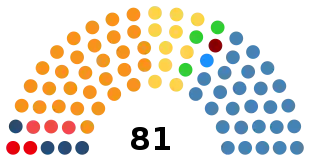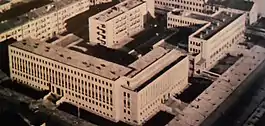Parliament of Montenegro
The Parliament of Montenegro (Montenegrin: Skupština Crne Gore, Скупштина Црне Горе) is the unicameral legislature of Montenegro. The Parliament currently has 81 members, elected for a four-year term. Following the 2006 independence referendum, the Parliament declared and ratified the independence of Montenegro on 3 June 2006. Members of the house are elected using proportional representation.
Parliament of Montenegro Skupština Crne Gore Скупштина Црне Горе | |
|---|---|
 | |
| Type | |
| Type | |
| Leadership | |
Vice Presidents | |
| Structure | |
| Seats | 81 |
 | |
Political groups | Government (41):
SNP (5) URA (4) PCG (1) Opposition (40): SD (3) BS (3) |
| Elections | |
| Proportional representation under the D'Hondt method | |
Last election | 30 August 2020 |
| Meeting place | |
 | |
| House of the Assembly Boulevard of Saint Peter of Cetinje, Podgorica | |
| Website | |
| www.skupstina.me | |
History
The Parliament of Montenegro was initially established by the Constitution of the Principality of Montenegro in 1905 and was called the Popular Assembly (Narodna skupština). It had a limited legislative role, limited by the authority of the Knjaz (Prince). The first parliament was constituted in 1906.[1] Following the incorporation of the Kingdom of Montenegro into the Kingdom of Yugoslavia in 1918, the Parliament of Montenegro was disbanded until World War II. The Parliament was reinstated in 1944, in the form of the Montenegrin Antifascist Assembly of National Liberation (CASNO), which changed its name to the Montenegrin National Assembly, and later the National Assembly. This lasted until 1946, when a new Assembly was elected for the FR Montenegro, a constituent republic within the SFR Yugoslavia. The current parliament is the 23rd since the foundation of the Parliament.
Powers
The Parliament appoints the Prime Minister nominated by the President, as well as the ministers chosen by the Prime Minister. Parliament also passes all laws in Montenegro, ratifies international treaties, appoints justices of all courts, adopts the budget and performs other duties as established by the Constitution. The Parliament can pass a vote of no-confidence in the Government with a majority of the members.
Deputies
A deputy has a four-year term. One deputy is elected per 6,000 voters, which in turn results in a change of total number of deputies in the parliament. Current assembly convening comprises 81 deputies instead of previous number of 75.
Elections

The Parliament has 81 members (deputies) elected by a D'Hondt method system of proportional representation for a four-year term.
The 81 seats of the Parliament of Montenegro are elected in a single nationwide constituency by closed list proportional representation. Seats are allocated using the d'Hondt method with a 3% electoral threshold. However, minority groups that account for at least 15% of the population in a district are given an exemption that lowers the electoral threshold to 0.7% if their list fails to cross the 3% threshold. For ethnic Croats, if no list representing the population passes the 0.7% threshold, the list with the most votes will win one seat if it receives more than 0.35% of the vote.[2]
2020 parliamentary election
| Party | Votes | % | Seats | +/– | |
|---|---|---|---|---|---|
| Democratic Party of Socialists | 143,548 | 35.06 | 30 | –6 | |
| For the Future of Montenegro | 133,267 | 32.55 | 27 | +6 | |
| Peace is Our Nation | 51,297 | 12.54 | 10 | –2 | |
| United Reform Action | 22,649 | 5.53 | 4 | +2 | |
| Social Democrats | 16,769 | 4.10 | 3 | +1 | |
| Bosniak PartyM | 16,286 | 3.98 | 3 | +1 | |
| Social Democratic Party | 12,839 | 3.14 | 2 | –2 | |
| Albanian ListM | 6,488 | 1.58 | 1 | 0 | |
| Albanian CoalitionM | 4,675 | 1.14 | 1 | +1 | |
| Croatian Civic InitiativeM | 1,115 | 0.27 | 0 | –1 | |
| Croatian Reform PartyM | 532 | 0.13 | 0 | New | |
| Invalid/blank votes | 4,503 | 2.09 | – | – | |
| Total | 413,954 | 100 | 81 | 0 | |
| Registered voters/turnout | 541,232 | 76.65 | – | – | |
| M — denotes the national minority lists, for which the 3% threshold does not apply. | |||||
Current parliamentary parties list
References
- History Archived 2015-09-21 at the Wayback Machine, skupstina.me
- Electoral system IPU